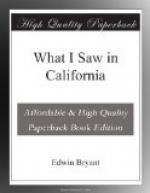On the evening of the 28th, a courier arrived with letters from Colonel Fremont, now at Monterey. The substance of the intelligence received by the courier was, that a large force of Californians (varying, according to different reports, from five to fifteen hundred strong) had met the marines and sailors, four hundred strong, under the command of Captain Mervine, of the U.S. frigate Savannah, who had landed at San Pedro for the purpose of marching to Los Angeles, and had driven Captain Mervine and his force back to the ship, with the loss, in killed, of six men. That the towns of Angeles and Santa Barbara had been taken by the insurgents, and the American garrisons there had either been captured or had made their escape by retreating. What had become of them was unknown.[2] Colonel Fremont, who I before mentioned had sailed with a party of one hundred and eighty volunteers from San Francisco to San Pedro, or San Diego, for the purpose of co-operating with Commodore Stockton, after having been some time at sea, had put into Monterey and landed his men, and his purpose now was to increase his force and mount them, and to proceed by land for Los Angeles.
[2] The garrison under Captain Gillespie,
at Los Angeles, capitulated.
The garrison at
Santa Barbara, under Lieutenant Talbot, marched
out in defiance
of the enemy, and after suffering many hardships
arrived in safety
at Monterey.
On the receipt of this intelligence, I immediately drew up a paper, which was signed by myself, Messrs Reed, Jacob, Lippincott, and Grayson, offering our services as volunteers, and our exertions to raise a force of emigrants and Indians which would be a sufficient reinforcement to Colonel Fremont. This paper was addressed to Mr. Kern, the commandant of Fort Sacramento, and required his sanction. The next morning (29th) he accepted of our proposal, and the labour of raising the volunteers and of procuring the necessary clothing and supplies for them and the Indians was apportioned.
It commenced raining on the night of the twenty-eighth, and the rain fell heavily and steadily until twelve o’clock, P.M., on the twenty-ninth. This is the first fall of rain since March last. About one o’clock, P.M., the clouds cleared away and the weather and temperature were delightful.
About twelve o’clock, on the 30th, accompanied by Mr. Grayson, I left New Helvetia. We crossed the Sacramento at the embarcadero, swimming our horses, and passing ourselves over in a small canoe. The method of swimming horses over so broad a stream as the Sacramento is as follows. A light canoe or “dug-out” is manned by three persons, one at the bow one at the stern and one in the centre; those at the bow and stern have paddles, and propel and steer the craft. The man in the centre holds the horses one on each side, keeping their heads out of water. When the horses are first forced into the deep water, they struggle prodigiously, and sometimes upset the canoe; but, when the canoe gets fairly under way, they cease their resistance, but snort loudly at every breath to clear their mouths and nostrils of the water.




